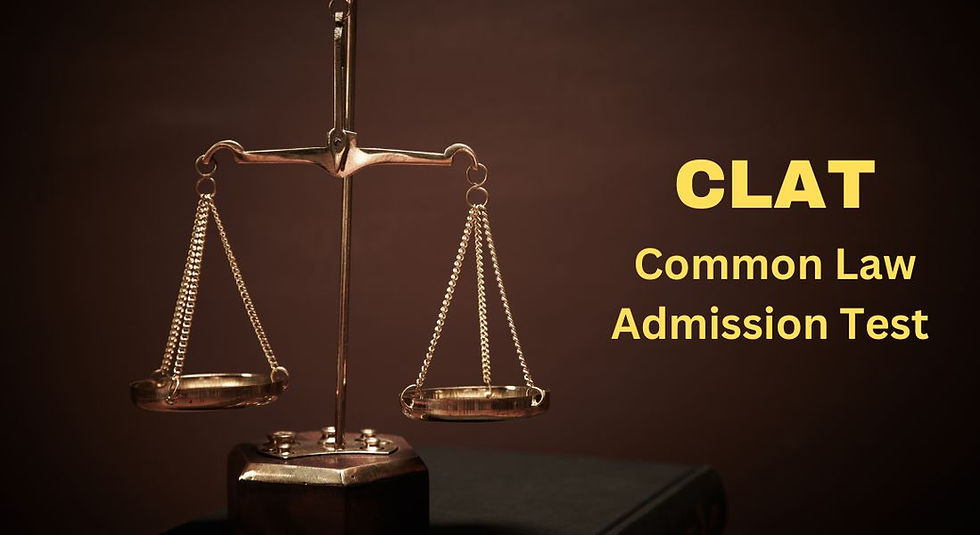CLAT 2026: Everything You Need to Know About the Exam
- Kanishka Makhijani
- Mar 10
- 4 min read
The Common Law Admission Test (CLAT 2026) is the most important entrance exam for students aspiring to pursue a career in law. Conducted by the Consortium of National Law Universities (NLUs), the CLAT exam is the gateway to securing admission into the top law schools in India. With thousands of students competing each year, it is essential to have a well-structured preparation strategy to crack the exam.
This blog provides an in-depth guide on CLAT 2026, covering all aspects such as eligibility, syllabus, exam pattern, important dates, preparation strategies, and expert tips to help you excel.

What is CLAT?
The Common Law Admission Test (CLAT exam) is a national-level law entrance exam conducted annually for admission to undergraduate (UG) and postgraduate (PG) law programs offered by 24 NLUs and other affiliated law colleges. The CLAT 2026 exam is expected to witness a large number of applicants due to its increasing popularity and the growing demand for legal education in India.
Why is CLAT Important?
Admission to Prestigious NLUs – Clearing CLAT 2026 gives you the opportunity to study at India’s top National Law Universities (NLUs).
Career Opportunities – A degree from an NLU opens up various career paths, including litigation, corporate law, judicial services, and more.
Scholarship and Financial Aid – Many NLUs offer scholarships and financial assistance based on CLAT scores.
CLAT 2026: Important Dates
While the official notification for CLAT 2026 is yet to be released, based on previous trends, here are the tentative dates:
Event | Tentative Date |
Release of Notification | July 2025 |
Start of Online Registration | August 2025 |
Last Date to Apply | November 2025 |
Admit Card Release | December 2025 |
CLAT 2026 Exam Date | December 2025 |
Result Declaration | January 2026 |
Counseling and Admission | January – March 2026 |
It is crucial to keep track of these dates and ensure timely completion of the registration process.
Eligibility Criteria for CLAT 2026
For UG (LLB) Program
Educational Qualification: Candidates must have passed Class 12 (or equivalent) from a recognized board.
Minimum Marks Required:
General/OBC/PWD/NRI candidates – 45%
SC/ST candidates – 40%
Age Limit: No upper age limit for appearing in CLAT exam.
For PG (LLM) Program
Educational Qualification: Candidates must have completed an LLB degree from a recognized university.
Minimum Marks Required:
General/OBC/PWD/NRI candidates – 50%
SC/ST candidates – 45%
Age Limit: No upper age limit.
CLAT 2026 Exam Pattern
The CLAT exam follows a specific pattern for both UG and PG courses. Understanding the exam pattern is essential for effective preparation.
CLAT UG 2026 Exam Pattern
Section | Number of Questions | Weightage |
English Language | 22-26 | 20% |
Current Affairs & General Knowledge | 28-32 | 25% |
Legal Reasoning | 28-32 | 25% |
Logical Reasoning | 22-26 | 20% |
Quantitative Techniques | 10-14 | 10% |
Total | 120 questions | 120 marks |
Duration: 2 hours
Marking Scheme: +1 for each correct answer, -0.25 for each incorrect answer
CLAT PG 2026 Exam Pattern
Section | Number of Questions | Weightage |
Constitutional Law | 60 | 50% |
Other Law Subjects (Jurisprudence, Contract, Torts, Criminal Law, International Law, etc.) | 60 | 50% |
Total | 120 questions | 120 marks |
Duration: 2 hours
Marking Scheme: +1 for each correct answer, -0.25 for each incorrect answer
CLAT 2026 Syllabus
1. English Language
Reading Comprehension
Vocabulary-based questions
Sentence correction
Para jumbles
2. Current Affairs & General Knowledge
National & International Events
Government Schemes & Policies
Legal Developments
Sports & Awards
3. Legal Reasoning
Legal principles
Case laws and judgments
Application of legal concepts
4. Logical Reasoning
Blood relations
Syllogisms
Statements & assumptions
Puzzle-based questions
5. Quantitative Techniques
Data interpretation
Percentages & Ratios
Time & Work
Probability
How to Prepare for CLAT 2026?
1. Create a Study Plan
Divide the syllabus into daily, weekly, and monthly targets.
Allocate more time to weaker areas.
Revise regularly.
2. Read Newspapers Daily
Focus on editorial sections for vocabulary and comprehension skills.
Stay updated with legal news and national events.
3. Practice Previous Year Papers & Mock Tests
Attempt at least 20-30 full-length mock tests.
Analyze mistakes and improve.
4. Join a Coaching Institute (If Needed)
Coaching institutes provide expert guidance and structured study materials.
Some of the best coaching centers include:
Law Prep Tutorial
Career Launcher
CLAT Possible
5. Improve Time Management Skills
Solve questions within a set time limit.
Prioritize sections based on strengths.
Best Books for CLAT 2026 Preparation
Section | Recommended Books |
English Language | Word Power Made Easy by Norman Lewis |
General Knowledge | Manorama Yearbook, The Hindu Editorials |
Legal Reasoning | Universal’s CLAT Guide |
Logical Reasoning | Analytical Reasoning by MK Pandey |
Quantitative Techniques | Quantitative Aptitude by RS Aggarwal |
CLAT 2026 Admit Card & Exam Day Guidelines
Admit Card Release: The admit card for CLAT 2026 will be available on the official website.
Documents Required:
Printed admit card
Valid ID proof (Aadhaar card, Passport, Voter ID, etc.)
Exam Day Guidelines:
Reach the center at least 30 minutes before the exam.
Do not carry electronic gadgets, books, or notes.
Follow all COVID-19 guidelines if applicable.
Conclusion
The CLAT exam is one of the most competitive law entrance tests in India, and thorough preparation is key to success. With the right strategy, consistent effort, and effective time management, you can secure a seat at one of the top NLUs through CLAT 2026.
Stay dedicated, practice regularly, and follow a structured approach to maximize your chances of success. Best of luck with your Common Law Admission Test preparation!



Comments